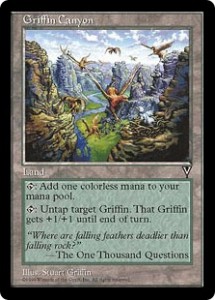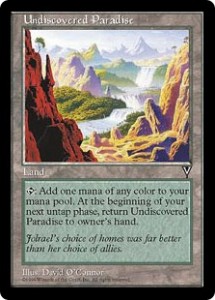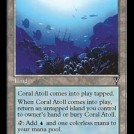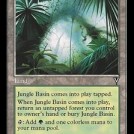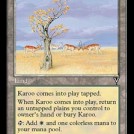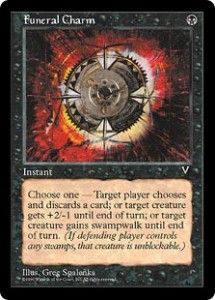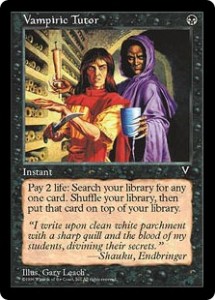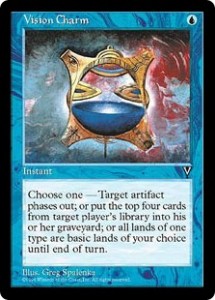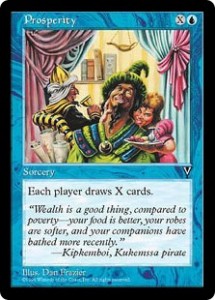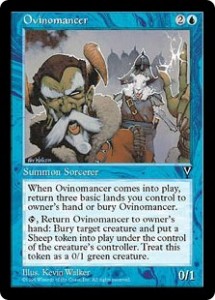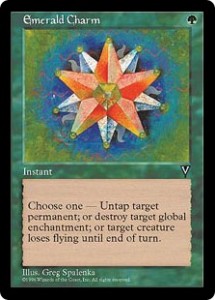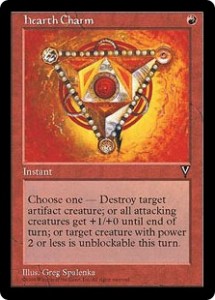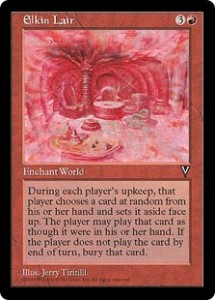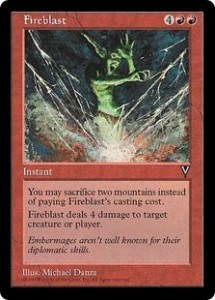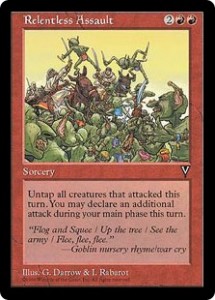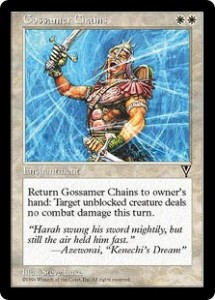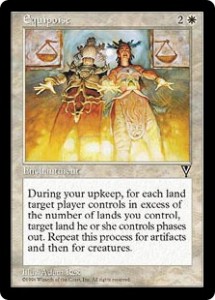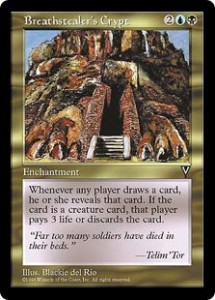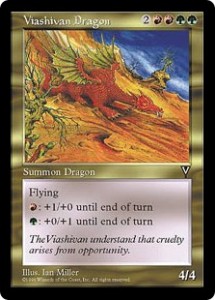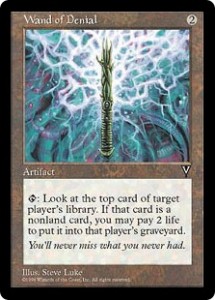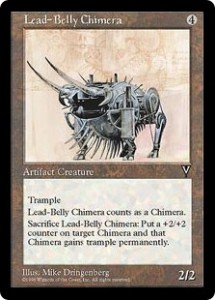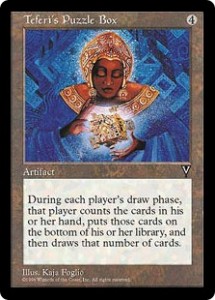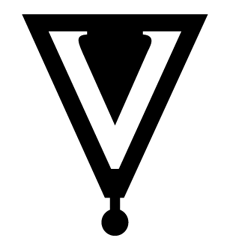
An Introduction to Visions
On February 3rd, 1997, Wizards of the Coast released Visions, an expansion set for Mirage, which was very much like Alliances was the expansion for Ice Age. It expanded upon the new rules from Mirage of Phasing and Flanking, as well as the charms and Enchant Creature or Instant cards. It also built upon the tribes that were boosted by Mirage; Dragons, Djinns, Efreets, Griffins and Knights.
It consisted of 167 cards; 8 Lands, 25 Black cards, 25 Blue cards, 25 Green cards, 25 Red cards, 25 White cards, 15 Multicolor or Gold cards and 19 Artifacts. It was the first set in a while, that didn’t have a balance across rarities; 62 commons, 55 uncommons and 50 rares.
Visions, expanded on the “pitch cards” of Alliances by creating cards that could be played without paying their casting costs, although another cost would be required, creatures with effects of a Sorcery, when they came into play were added, and there were additional cards with Phasing and Flanking, building upon the foundation of of those abilities introduced in Mirage.
There was plenty of card draw, a new atog in Chronatog, a new tutor in Vampiric Tutor, Lands that could be tapped for one colorless and one colored Mana were added for each of the five colors and a new 0 casting cost Artifact Creature in Phyrexian Walker. It also created a new tribe for Artifact Creatures called Chimeras.
Visions also continued the heavy creature emphasis that started in Mirage, as 73 of the 167 card set was creatures. For those of you scoring at home that’s a tad under 44%. The other interesting thing about those 73 creatures is that Visions did not contain one Legend. This was not just for creatures either, there were no Legendary lands or either, which was a bit surprising, considering it was the first set since Fallen Empires that did not contain a Legend.
Visions had power cards and powerful commons that were and are both used and underused. It was the perfect followup to Mirage, just like Alliances was a great followup to Ice Age.
The Lands of Visions: Two Mana in a Tap, A Griffin Land, Quicksand a Bounce back Land
There were eight Lands in Visions, two useful Lands, in Griffin Canyon and Quicksand, one power Land in Undiscovered Paradise and five colored that could be tapped for the one colorless and one colored Mana.
Griffin Canyon was a boon for Griffin decks, which hadn’t even existed until Mirage was printed. You could tap it for one colorless Mana or you could tap it to untap target Griffin giving it a +1/+1 boost until end of turn.
This seems like a bust, but it’s not. There are plenty of useful ways to tap creatures, find one of them and use it. Then untap the Griffin for a boost and attack. Or you could attack with your Griffin and then untap him as a blocker with an added +1/+1 bonus.
The best part being that this is not a legendary Land, so if you could get two or three out, you can attack or use abilities as you wish and then just untap multiple Griffins for blocking purposes, ad infinitum.
Quicksand, on the other hand, was a straightforward defensive card. You could tap it for one colorless Mana, or you could tap it and sacrifice it to give “target attacking creature without flying” -1/-2 until end of turn.
This seemed to be a different take on Desert from Arabian Nights, which tapped to deal one damage to target attacking creature. Whether it was or it wasn’t is up for debate, but it was useful none-the-less.
Undiscovered Paradise was the standout power Land of Visions. “TAP: Add one mana of any color to your mana pool. At the beginning of your next untap phase, return Undiscovered Paradise to owner’s hand.” This was immensely useful. It went into all of those Erhnageddon decks, so along with the Diamonds of Mirage you would have plenty access to Mana when you needed it.
Also, it went into your hand, before your untap phase, so it was in your hand in time for any upkeep effects, such as Ivory Tower or Black Vise. Now, it did slow your Mana production down, as using it on multiple turns in a row, meant that it was the only Land you were putting in play, but there were plenty of cards, especially if you were playing Green, that could get you around the one Land per turn limit.
The colored Lands were Coral Atoll for Blue, Dormant Volcano for Red, Everglades for Black, Jungle Basin for Green and Karoo for White. Each of them came into play tapped and each needed to have an untapped Land of the corresponding color’s basic Land type returned to your hand when it was cast.
These cards were a risky play back when Mana burn was still in the rule book, but today, you don’t have to worry about not spending that last colorless Mana, because it won’t cost you any life at all.
The Color Black in Visions: Discard, Boost, Reanimate and Search to Destroy
Black had quite a few powerful additions added to its already powerful arsenal coming of of Mirage. Funeral Charm, the second Black charm, gave you the choice to have target player discard a card, give target creature +2/-1 until end of turn, or gave target creature swampwalk until end of turn. The latter wasn’t used much, but the option to boost a creature’s power or have your opponent discard a card was beyond useful for discard decks. Discard decks, were also boosted by Coercion, which allowed you to choose the discarded card.
There were a lot of small but useful creatures added to Black’s army. Crypt Rats had the ability of Pestilence, but it could only be powered by Black Mana. Brood of Cockroaches and Necrosavant could both be brought back from the graveyard, the Brood to your hand and the Necrosavant back into play.
Fallen Askari was a better version of Erg Raiders, because it had Flanking and it didn’t damage you if it did not attack. Nekrataal was a 2/1 first strike creature that had the effect of a Terror when it was cast. Suq’Ata Assassin was a creature that could give opponent’s poison counters and had a built in Fear. But it wasn’t all small creatures.
Aku Djinn was a 5/6 trample, that boosted each of your opponents’ creatures with a +1/+1 counter during your upkeep, but the idea was to make sure they didn’t have any creatures to boost or to trade Aku with your opponent, so your creatures would be boosted every turn.
Reanimator decks were beyond ecstatic to see Necromancy, an Animate Dead that could be played as an Instant and did not give the creature a permanent -1/-0. Fans of Mirage’s Foresaken Wastes were equally as happy to see Pillar Tombs of Aku, which made each player sacrifice a creature during their upkeep or pay five life to destroy the Enchant World.
Dark Privilege was a black Carapace, only instead of giving the enchanted creature +0/+2, it was +1/+1 and you didn’t have to sacrifice the enchantment to regenerate enchanted creature, you just had to sacrifice a creature.
Blanket of Night was a boon for Black decks featuring swampwalking as it made every Mana-producing land a Swamp, in addition to its normal Land type. This meant that in addition to all Lands now being able to produce Black Mana, cards like White’s Angry Mob and Black’s Nightmare could be very big even in two color decks.
Black really gained a lot as far as deadly direct damage in Visions. Forbidden Ritual allowed you to sacrifice a card in play to make target player lose two life, that player may sacrifice a permanent or discard a card to prevent the loss of life. This could be repeated as many times as you like until you run out of cards to sacrifice or your opponent is dead.
Kaervek’s Spite on the other hand was a game ending Instant; “sacrifice all permanents, discard your hand: target player loses 5 life.” It was a endgame play, because if that didn’t kill your opponent, you’d have no hand or cards in play to defend yourself with.
But the Black card everyone was talking the most about in Visions was Vampiric Tutor. Based upon the other tutor’s from Mirage, this was a card we never thought we’d see, back in 1996 when Mirage was released, but here it was in 1997 as a part of Visions. Now, it wasn’t a Demonic Tutor, which cost an additional colorless Mana and put the card directly into your hand, but the cheap cost and the additional two life required for the spell was not a problem.
Even if it was going to the top of your library, because it was an Instant, which meant that most people cast it at the end of their opponent’s turn, so they didn’t have to wait to draw what they had chosen to select from their library.
The Color Blue in Visions: Skip your Turn, Card a Draw, Counters and Sheep
Blue, always about control, had even more control in Visions. Card draw, counters, phasing, and many ways to deal with creatures.
The Blue charm was Vision Charm, which allowed you to have an Artifact phase out, put the top four cards from target player’s library into their graveyard or make all Lands of one type Basic lands of another type of your choice. Millstone decks benefited the most from the second option, for obvious reasons.
Desertion was an expensive Counterspell, for three colorless and two Blue Mana, but if the countered spell was an Artifact or a creature, that card was put into play under your control, making it a Counterspell and Control Magic or Steal Artifact in one. Undo, was a Boomerang on steriods that cost more, but let you return two target creature’s to their owner’s hand.
First, there was Atog in Antiquities (also reprinted in Revised), followed years later by Foratog in Mirage and then came Blue’s Atog in Chronatog, which didn’t eat Artifacts or Forests, but turns. Chronatog, allowed you to skip your turn so that it could get a +3/+3 boost. This was used in combination with many other cards including Stasis.
Would you like to draw a card? Visions had immense card draw. Betrayal, allowed you to enchant an opponent’s creature and draw a card whenever it was tapped. This was even better if you had an Icy Manipulator in play. Inspiration was an Instant that said, “target player draws two cards,” so, of course, most of the time, players targeted themselves.
Although Braingeyser hadn’t been seen since Revised, a version of it was printed in Visions with Prosperity, only instead of targeting a player to draw X cards, all players drew X cards. This was a very worthwhile play if you had a Black Vise on your opponent, because you’d get the card draw and they would be taking damage during their next upkeep.
Three Wishes wasn’t a standard card draw play, but it worked nicely in a pinch or even better if you knew what your next three draws would be. “Take the top three cards from your library, look at them, and set them aside face down. You may play those cards as though they were in your hand. At the beginning of your next turn, bury any of those cards not played.” It was a risk, but if the cards could be used, it was a huge advantage to you. Also, it could be used to get big creatures into your graveyard for reanimator decks.
But Blue wasn’t all about spells and drawing cards, it had creatures too. Blue’s first official knight was printed in Visions with Knights of the Mists, although later errata would make Fallen Empires‘ Vodalian Knights an official knight in addition to being a Merfolk. Man-o’-War was a 2/2, with a creature Boomerang effect when it came into play and Shrieking Drake was the same, except if was for a creature you control.
Phasing was boosted in Visions’ Blue cards with Rainbow Efreet, which had the ability to phase out, but didn’t have actual Phasing. Shimmering Efreet did have Phasing and when it phased in, you were able to have target creature phase out.
Phasing wasn’t just for creatures to have as an ability, Time and Tide was an Instant that made all phased out creatures, phase in and all phased in creatures phase out. But the control of Phasing really belonged to Teferi’s Realm. “At the beginning of each player’s upkeep, that player chooses artifacts, creatures, lands, or global enchantments. All cards of that type phase out.” Yes, every player would target something different, so in order to play Teferi’s Realm, you would need to have a balanced deck, not hinged upon just creatures.
Mystic Veil was an Enchant creature that could be played as an Instant and made the Enchanted creature unable to be the target of spells or effects. This was a great ace in the hole, so to speak, as it cost the same as an Arcane Denial and could protect any creature you needed to, with the same impact of a counter.
One of the most intriguing creatures in Visions, let alone Blue Visions, was Ovinomancer. First off, “when Ovinomancer comes into play, return three basic lands you control to owner’s hand or bury Ovinomancer.” That would be fine for any card that you’d only be casting once, but for Ovinomancer’s ability. Tap Ovinomancer and return it to owner’s hand to bury target creature and have that creature’s controller put a 0/1 Sheep token into play.
Unless, you had a lot of land out, this was not going to happen every turn, because you’d need to have three basic Land in play to cast it in the first place. None-the-less, it was great being able to turn Shivan Dragons, Serra Angels, Sengir Vampires, Mahamoti Djinns and other big creatures into 0/1 Sheep tokens.
The Color Green in Visions: Summer, Solitude, Land Manipulation and even Card Draw
Vision’s Green legacy was mainly about creatures and land manipulation. Emerald Charm the Green charm allowed you to, untap target permanent, destroy target global enchantment or remove flying from target creature until end of turn. As enchantment destruction goes, this is a very useful card, as you may use it as you see fit.
Mortal Wound was a creature enchantment that destroyed that creature if any damage was dealt to it. Katabatic Winds was a Phasing enchantment, that prevented creatures with flying from attacking or using any ability with Tap as an activation cost.
Ehrnageddon decks, got Bull Elephant which returned two Forests you control to owner’s hand when it came into play, meaning that if you timed your Armageddon properly, you’d have two Forests to rebuild your Mana pool with. And all of that Mana would come into play when you consider all the things that four Mana could buy you in Green in Visions.
Creeping Mold, for example, could destroy target Artifact, Land or Enchantment, Elven Cache could return any card from your graveyard to your hand. King Cheetah was a 3/2 that could be played as an Instant and Natural Order allowed you to sacrifice a creature to search your library for a creature and put it into play as if it were just summoned. Not to bad for only four Mana.
Looking for something cheaper? Quirion Druid could permanently turn a Land into a 2/2 Green creature, while still counting as a land. Quirion Ranger, allowed you to return a Forest to owner’s hand in order to untap target creature. River Boa was a 2/1, regenerating, Islandwalk creature. This was a great card to cast against Blue, but only if you could get it into play.
With Rowen, you could use all the library manipulation from Alliances to guarantee a card draw. “During your draw phase, reveal the first card you draw to all players. If that card is a basic land, draw a card.” Of course, without library manipulation this is still a valuable card, but you’ll have to play with the fact that your opponent, will know what you have in your hand after a few turns.
Summer Bloom, was a great card with Ovinomancer. It was a Sorcery that allowed you to play up to three additional lands during your turn. This could allow you to use your Ovinomancer, for an extra turn, because the three land you just returned to your hand, could be put back into play.
In fact, if you played the Ovinomancer, you could return the three Mana, you tapped to cast it, to your hand and then use Summer Bloom to put them back into play and use them again.
However, the standout card of Green in Visions was the Enchantment City of Solitude. “Each player may play spells and abilities only during his or her turn.” This was an epic card not just for Green, but for any color that wasn’t Blue. This was a boon and the ultimate defense against Counterspells and the other counters in Blue’s arsenal. Of course, you needed to get in into play first. But once it was there, you were home free.
The Color Red in Visions: Tribes, Creatures that Won’t Die and two Attack Phases
Building off of Mirage, Red in Visions had more direct damage, expanded upon existing tribes and had some very useful creatures.
The Red charm was Hearth Charm, which allowed you to destroy an Artifact creature, give all attacking creatures +1/+0 or make target creature with a power two or less unblockable until end of turn. I never saw the first option used, but the second and third options were used quite regularly.
The tribal adds were Dwarven Vigilantes for the Dwarves, Raging Gorilla for the Gorillas, Talruum Champion and Talruum Piper for the Minotaurs and a whole lot of Goblins.
Golbin Swine-Rider was alright, but the Goblin Recruiter was beyond useful. The Recruiter acted as a Goblin tutor of sorts, allowing you to look through your library and put any number of Goblin cards on top of your library in any order, when it came into play. The third Goblin added to the tribe was Keeper of Kookus, a 1/1 that could be given protection from Red until end of turn, but that was not it’s only function.
Kookus was a 3/5 djinn that could be given +1/+0 for one Red Mana until end of turn, for however many Mana you could spare, but if you didn’t control a Keeper of Kookus, it would deal you three damage during your upkeep and was forced to attack during your turn if able.
The best play for these cards was having one Keeper of Kookus out, meant you could cast as many Kookus cards as you wished. And since Kookus only cost three colorless and two Red Mana, this was easily done in Red/Green decks.
Elkin Lair, was an Enchant World that was essentially a Three Wishes from your hand for each player during every turn. If you didn’t use the card it get’s buried at the end of your turn, but not having it in your hand could be useful for cards that made you discard your hand, thus you’d still be able to cast the card, after discarding your hand.
It also forced an opponent to spend their Mana to cast the chosen card or lose it, which was a great way to force a player of Blue to tap out, leaving you only to have to worry about a Force of Will, as opposed to a Counterspell or Arcane Denial.
Song of Blood was a Sorcery that said put the top for cards from your library into your graveyard and then gave all creatures that attacked that turn, a +1/+0 boost for each creature card put into your graveyard that way.
This was an instant +4/+0 boost if you had used the Goblin Recruiter to stack your deck with creatures at the top. This was not a bad way to end the game, if you just needed to get a few creatures through and needed to boost those creature’s power.
Fireblast was a hugely popular variation on the “pitch cards” from Alliances. It was a four colorless and two Red Mana costing direct damage spell that could do four damage to any target creature or player, but you could sacrifice two Mountains instead of paying it’s casting cost.
Depending on when you needed to use it, or if it was going to be the final blow, meant having to decide if to use it, but it proved to be deadly more often than not for the person it was played against.
Ogre Enforcer was a safeguard against the ping decks of the time. It was a 4/4 that could “not be destroyed by lethal damage unless a single source deals enough damage to destroy it.” This wasn’t an easy feat for any non Red color, except Black. So it was easier to keep around, as blocking a 3/3 with it would not mean it could be pinged for the last damage.
On a more offensive note, Relentless Assault gave players an extra attack phase and it untapped all creatures that attacked this turn. This was not only a great way to attack your opponent twice, but it could also be used defensively, to attack your opponent and then untap all your creatures for defense. Also, imagine casting this after having stacked your deck with the Goblin Recruiter for Songs of Blood. That’s attacking twice with an army that has +4/+0.
There were two bounce back creatures for Red in Visions. Bogardan Phoenix was a limited Ivory Gargoyle, in that it could only come back once, after that it was removed from the game when it died the second time. Of course, you could return it to your hand and have it die three turns, if you could muster that, but it cost two colorless and three Red Mana to cast, so it wasn’t cheap.
But there was a cheap bounce back creature for Red in Viashino Sandstalker.
Viashino Sandstalker only cost one colorless and two Red Mana. It was a 4/2 that was unaffected by summoning sickness and was returned to owner’s hand at the end of any turn. This meant that the Sandstalker would need to be killed or countered, because it couldn’t be stolen for more than a turn.
It may not have had many decks completely devoted to it, like Ball Lightning for example, but it found it’s way into a lot of mono-Red decks, when it first came out.
The Color White in Visions: Knights, Prevention, Lock down Controls and a Tutor for Plains
White in Visions had the usual White weenies, we were accustomed to seeing and added to some tribes, but it also had a lot of control spells that could give you a lock in the game.
Hope Charm the White charm, allowed you to give target creature First Strike, gain to life or destroy target local enchantment. The best use was the ability to give a creature First Strike, because as an Instant it was a great way to keep you creature alive, if your 4/4 was blocked by a 4/4. The ability to gain life from the charm also made if a viable deck option, because of it’s versatility.
Archangel was just a Serra Angel for two more colorless Mana and was just a 5/5 instead of being a 4/4. It’s notable, because it was a continuation of the growing Angel tribe. Dajara Griffin was another addition for the Griffins and the White Knights had three additions; Knight of Valor, Teferi’s honor Guard and Zhalfirin Crusader.
Teferi’s honor Guard was a 2/2 with Flanking that for two Blue Mana could phase out, which was useful for keeping it safe against Wrath of God, meanwhile, the Zhalfirin Crusader, also with Flanking could redirect one damage from itself to target creature or player for one colorless and one White Mana. If your resources were strong enough, you could use the Crusader to hurt your opponent and keep the Crusader alive for many turns.
Gossamer Chains was a unique Enchantment, in that it cost two White Mana and could be returned to your hand to have target unblocked creature deal no combat damage. This was great and could be used over and over again as a personal fog for whatever creature you decided not to block.
Miraculous Recover was a White reanimator, allowing you to bring target creature card from your graveyard into play with a +1/+1 counter on it. Although it was an Instant, it did cost four colorless and one White Mana, so even with the expense, it was a great fit in Black White reanimator decks.
If you were playing a White weenie deck, you’re biggest issue was going to be big creatures, as most of your army won’t be bigger than a 2/2, but Retribution of the Meek leveled the playing field, by burying all creatures with power four or greater. This was huge against the massive Red, Black and Green creatures of the day.
The White control I mentioned earlier came from three cards; Equipoise, Eye of Singularity and Peace Talks.
Equipoise was a permanent Balance. It was a two colorless and one White Mana costing Enchantment, that during your upkeep, made each Land a player owned in excess of the number of Lands you controlled phase out, a process which was then repeated for Artifacts and creatures. This was a great card to hold onto, until after your army was massacred, because your opponent would have to phase out all of their creatures. For White Green decks relying on creatures for Mana, it allowed you to sacrifice your Lands to a Zuran Orb and leave your opponent Mana-less.
Eye of Singularity, made every card Legendary. This was a huge advantage for the player of the card, because you could build your Green White deck with two Llanowar Elves and two Fyndhorn Elves, knowing that you’d be able to keep two in play, as opposed to your opponent, who would have to bury any beyond the first in play. This would leave you with two Mana-producing creatures as opposed to one, all because you knew it was coming. But again, it was all based upon how you built your deck.
Peace Talks, was a Sorcery that prevented players from declaring attacks or playing spells and abilities that targeted any permanent or player. This didn’t protect your from Counterspells per se, but it would keep you from have having to deal with an attack or any direct damage for two turns, which for White was a huge advantage.
When Visions came out Land Tax was restricted in some tournament formats, but Tithe was an easy way to get round this, that was until Tithe was restricted itself. It allowed you to search your library for a Plains and put that Plains into your hand. If you controlled fewer land than your opponent, you were able to search for an additional Plains and put both into your hand. Because it only cost one White Mana, this was a great second turn play, if your opponent went first, as usually by the start of your second turn, they would have two Lands in play.
The Gold of Visions: Creatures, Counters, Damage and Mana
The Gold or Multicolored cards in Visions were all very multifaceted and most could be extremely dangerous to your opponent or helpful to you in the right kind of deck.
Guiding Spirit gave White Blue a reanimator mechanic. “TAP: If the top card of target player’s graveyard is a creature card, put that card on the top of that player’s graveyard,” which essentially, made all of your creature’s able to have many lives, unless of course they were removed from the game.
Righteous War, was as balanced as cards come, because it gave all White creatures protection from Black and all Black creatures protection from White. This could be helpful, but it could also be a hindrance, if you were playing your Black White deck against another Black White deck, effectively making all creatures immune to all spells.
Breathstealer’s Crypt was brilliant, especially in melee games, because if a player drew a creature card, they would have to pay three life or discard the card. This was based on any draw, not just during their draw step, so it meant that a Prosperity for four, could do up to 12 damage, if a player drew four creature cards and that player wanted to hold onto them. While Mundungu was a Force Spike with the added benefit of making the player lose a life, as well.
Pygmy hippo was similar to The Dark’s Mana Drain only it didn’t counter a spell and it didn’t just give you some of your opponent’s Mana, it gave you all of their Mana during the remainder of your turn. Now although this was colorless Mana, there were ways of turning it into a color, should you choose to, but if you saved a Mountain, you could essentially disintegrate them with their own Mana.
Firestorm hellkite was a 6/6 Flying, Trample Dragon with a Cumulative Upkeep of one Blue and one Red Mana. This expense could get very large, but with all of the ways that there were to return it from the graveyard, not paying its upkeep cost, would only negate it for a turn or two, then you could get it back and recast it, starting the Cumulative Upkeep over anew.
Army Ants was a great Land destruction card at “TAP: Sacrifice a land: Destroy target land.” So if you were equipped to bring Land back from your graveyard, or use Soldevi Digger, to put your sacrificed Land on the bottom of your library, with a “shuffle your library card” you wouldn’t completely lose your Mana indefinitely. If you were playing against an Artifact heavy deck, Corrosion, which could destroy lots of Artifacts over time, was a good play, just make sure you don’t hurt your own Artifacts by burying them, as well.
Viashivan Dragon was the Red Green Spirit of the Night, as it could be cast without paying its casting cost and without having it in your hand by sacrificing the Green Drake of Kyseu Drake and the Red Drake of Spitting Drake. Both of the Drakes cost three colorless and one of their corresponding color’s Mana, so in a Red Green deck, with Elves and Birds of Paradise, that Viashivan Dragon could make a surprise appearance on turn three or four.
Although, Homelands was the last set to have an Artifact bury all cards from its own set, Suleiman’s Legacy was similar, in that when it came into play it buried all Djinns and Efreets and as long as it was in play, any that were cast would be buried as well.
Femeref Enchantress was huge with Verduran Enchantress and Rabid Wombat, because it allowed you to draw a card when an enchantment was put into any graveyard from play. This meant that if your opponent managed to destroy your 6/7 Rabid Wombat, you’d be drawing three cards for the three enchantments that were on it, allowing you to restock up your hand with possibly more enchantments and maybe even another Wombat.
However, with all of that Squandered Resources was quite possibly the most dangerous of the Gold or Multicolored cards in Visions. It was great for gaining that extra Mana if and when you needed it. “Sacrifice a land: Add to your mana pool one mana of any type the sacrificed land could produce,” which meant that you could tap an Ice Age pain Land for one color Mana and sacrifice it for the other color, without taking two damage. With Squandered Resources the possibilities were endless, especially if you could get your Land back from the graveyard.
The Artifacts of Visions: Chimeras, Wands, Walkers, Snakes and a Puzzling Box
The Artifacts of Visions were useful in many decks and more useful still against other decks. Visions also had a tribe in its Artifacts of the Chimeras. There were four Artifacts that stood above the rest in Phyrexian Walker, Sands of Time, Snake Basket and Teferi’s Puzzle Box
Would you like all spells to “cost one generic mana less to play?” Then put a helm of Awakening into play, just remember it affects everyone, not just you. Want to build up a direct damage spell to catastrophic porportions and then destroy your opponent with it? Magma Mine has you covered. Want an expensive Sol Ring? Sisay’s Ring will give you two colorless Mana, but it costs four colorless Mana to cast.
Is your opponent spending a lot of time and resources manipulating their library to set up a great draw? Wand of Denial will let you look at the top card of their library and if it’s not a Land, you can pay two life to put it into their graveyard and spoil the draw they just set up. Looking for a duel to the death? Triangle of War will allow you to choose a creature you control and one an opponent controls and have them each deal damage equal to their power to the other.
There were four Chimeras in Visions as a tribe of Artifact creatures that now numbers 11 in existence, but it started with these four; Brass-Talon, Iron-Heart, Lead-Belly and Tin-Wing Chimera. All had their own ability of First Strike, Attacking does not cause to tap, Trample and Flying. Each could be sacrificed to put a +2/+2 token permanently on target Chimera and along with the token, the ability was given to that Chimera as well, so if you had all four out, you could sacrifice three and have an 8/8 Chimera with First Strike, Flying, Trample and Attacking does not cause to tap. They all cost four Mana, but for an 8/8 with all that ability not to have an upkeep is pretty impressive.
Diamond Kaleidoscope was like the Jungle Patrol from Mirage, except instead of producing 0/1 walls, it produced 0/1 Artifact creatures and instead of being able to sacrifice them for Red Mana, you could sacrifice them for any one color of Mana chose. This was a must for some decks, because it was a way to gain additional Mana sources of any color.
For all of those creatures that you’d want to bounce back to your hand, before their upkeeps did you in, there was Dragon Mask. Dragon Mask gave target creature you control +2/+2 and if it was still in play at the end of that turn, you returned that creature to your hand. If you weren’t going to be able to pay for the upkeep next turn anyway, this is a great way to use it or lose it and if it survived the turn, you could recast and repeat the process until you ran out of cards to draw.
Anvil of Bogardan was like a Howling Mine but completely off the rails. First off, “each player skips his or her discard phase,” which could lead to some very interesting combos, most famously Ivory Tower. Second, “during each player’s draw phase, that player draws and additional card and then chooses and discards a card.”
This was a good card until Stronghold’s Megrim was printed and then it became a great part of that combo, because Megrim damages every opponent for two damage, whenever an opponent discards a card. That means every turn, your opponent was discarding a card and taking damage, while you were just discarding a card, which is a great trade off.
However, the four Artifacts that had a lasting impact on the game were Phyrexian Walker, Sands of Time, Snake Basket and Teferi’s Puzzle Box.
Phyrexian Walker was a non-flying Ornithoper, at least that how it was viewed. It was a 0/3 that cost zero to cast. Of course, like the Ornithopter, Phyrexian Walker would gain a new life in Tempest with the advent of Goblin Bombardment, in conjunction with Ice Age‘s Enduring Renewal, as part of an infinite damage loop combo.
Sands of Time could create a temporary Stasis every other turn, because at the beginning of each player’s turn, it tapped each Artifact, creature and Land that was untapped and untapped each of those which was tapped. Yes, this could be played through, but if you timed it right, you could really handicap your opponent for a turn or two.
Snake Basket cost four colorless Mana to cast and could be sacrificed with X Mana to create X 1/1 Snake tokens. Yes, you could just save up your Mana and pop it for a bunch of Snake tokens, but when paired with a Pygmy hippo, you could pop it for a whole lot more Snake tokens, all paid for by your opponent.
One of the most confounding Artifacts of “Old School” Magic was Teferi’s Puzzle Box. “During each player’s draw phase, that player counts the cards in his or her hand, puts those cards on the bottom of his or her library, and then draws that number of cards.”
This was a great way to keep an opponent from stockpiling his or her hand with a combo play, but it was a card from Legends, that was to be reprinted in 2003’s Eight Edition, Underworld Dreams, that gave this card a deadly combo.
Underworld Dreams dealt every opponent of yours one damage for each card they draw. So that cantrip card, deals them a damage for the draw, during their draw phase they take a damage for the draw, and if they have five cards in their hand and Teferi’s Puzzle Box is in play, it deals them five damage during their draw. This was a winning combo, that could be very deadly not only in duals, but in melee games, as well.
In Conclusion Visions
As a follow up to Mirage, again, Visions was very similar to the follow up that Alliances was for Ice Age. It took the themes and tribes from Mirage and built upon them.
It added more Flanking creatures to Magic and it added Phasing, and not just for creatures, with more control and more variation. It continued the charms that started in Mirage and it also continued the now burgeoning tribe of Dragons.
Visions also had some anti-Alliances cards that would undo some of the massive library manipulation that could be found in Alliances. The theme of one set being able to deal with the style of play that was developed in a prior set, such as Visions with the library manipulation of Alliances was something that would begin to ebb and flow with each new set printed from Visions on out.
Visions impact on the game was the same as Ice Age’s, Alliances’ and Mirage’s impact on the game, which was that it tweaked the way the game was played. It made some cards from other sets more powerful in some combinations and nullified others. It was a complex set, with cards that were overused and underutilized and that’s why as an expansion, it might not measure up to the massive changes wrought by Alliances, but it still changed the game in it’s own way.
With Alliances and Visions, Wizards of the Coast had found a well manufactured formula for the expansion sets to stand alone expansions.


